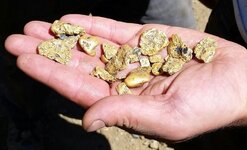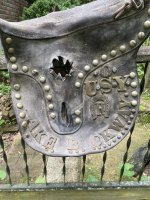Bob in Oregon
Jr. Member
- Aug 31, 2017
- 30
- 35
- Detector(s) used
-
GPX, SD2200d
XP Deus
- Primary Interest:
- Metal Detecting
Hi all,
The past couple of outings, I’ve been detecting in a 100+ year old large public park using the stock V.4 hot program without making any setting adjustments. While detecting numerous randomly located areas, the mineralization bar on the right goes up from 4-5 to almost the top of the bar, hovers there a bit fluctuating slightly over a small area roughly 50 to 100 sq ft. and then as quickly goes back down to 4-5. The upper left ground mineralization index number generally fluctuates between 82 and 87 in most areas of the park.
I’ve found a number of coins (nothing older than the late 70’s), caps, pulls and some trash but, nothing below 6 inches or so. I’m guessing that other detectorists have likely struggled with depth and maybe missed deeper coins in a number of areas within this park getting through the mineralization.
The program is fairly chatty, almost bordering on distracting but I seem to be getting used to it and I’ve heard a couple of what sounded like ever so slight, very faint lifted signals without a TID number and the right tip of the horseshoe going black. I’ve dug them only to find nothing in the hole........
I’ve read Andy’s chapter on ground balancing but I’m left wondering if the GB tracking feature would be better suited for my conditions instead of the pre-set 90 and also what “ground notching” is, what benefit it might have in this situation and, how someone might experiment with this feature to best set it up properly for their specific area without unduly compromising the depth potential of the machine.
Thanks for your help and patience with the newbie questions.
Best,
Bob
The past couple of outings, I’ve been detecting in a 100+ year old large public park using the stock V.4 hot program without making any setting adjustments. While detecting numerous randomly located areas, the mineralization bar on the right goes up from 4-5 to almost the top of the bar, hovers there a bit fluctuating slightly over a small area roughly 50 to 100 sq ft. and then as quickly goes back down to 4-5. The upper left ground mineralization index number generally fluctuates between 82 and 87 in most areas of the park.
I’ve found a number of coins (nothing older than the late 70’s), caps, pulls and some trash but, nothing below 6 inches or so. I’m guessing that other detectorists have likely struggled with depth and maybe missed deeper coins in a number of areas within this park getting through the mineralization.
The program is fairly chatty, almost bordering on distracting but I seem to be getting used to it and I’ve heard a couple of what sounded like ever so slight, very faint lifted signals without a TID number and the right tip of the horseshoe going black. I’ve dug them only to find nothing in the hole........
I’ve read Andy’s chapter on ground balancing but I’m left wondering if the GB tracking feature would be better suited for my conditions instead of the pre-set 90 and also what “ground notching” is, what benefit it might have in this situation and, how someone might experiment with this feature to best set it up properly for their specific area without unduly compromising the depth potential of the machine.
Thanks for your help and patience with the newbie questions.
Best,
Bob







